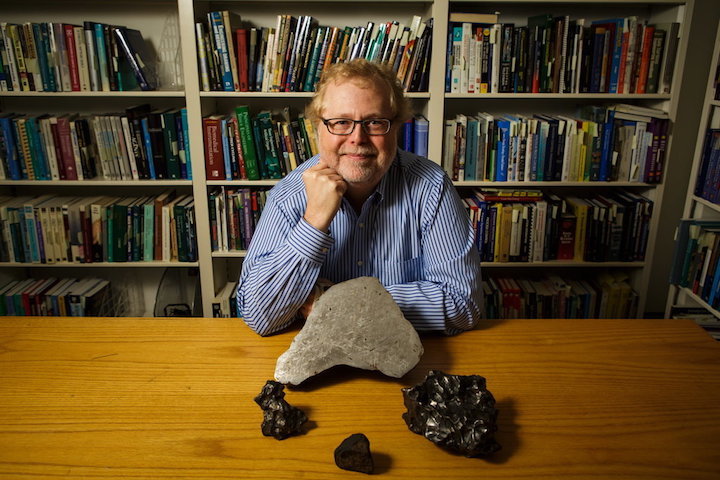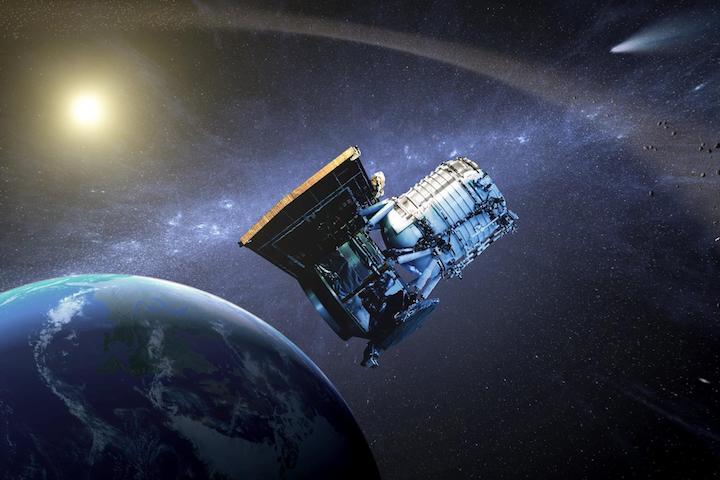15.06.2018
Two years ago, NASA dismissed and mocked an amateur’s criticisms of its asteroids database. Now Nathan Myhrvold is back, and his papers have passed peer review.

Thousands of asteroids are passing through Earth’s neighborhood all the time. Although the odds of a direct hit on the planet any time soon are slim, even a small asteroid the size of a house could explode with as much energy as an atomic bomb.
So scientists at NASA are charged with scanning the skies for such dangerous space rocks. If one were on a collision course with our planet, information about how big it is and what it’s made of would be essential for deflecting it, or calculating the destruction if it hits.
For the last couple of years, Nathan P. Myhrvold, a former chief technologist at Microsoft, has roiled the small, congenial community of asteroid scientists by saying they know less than they think about these near-Earth objects. He argues that a trove of data from NASA they rely on is flawed and unreliable.
Since 2011, a NASA project known as Neowise has cataloged the sizes and reflectivity of 158,000 asteroids, and it claimed that its diameter estimates were often within 10 percent of the actual size. Dr. Myhrvold said the uncertainties were much greater, largely because NASA researchers were using data from a satellite designed for observing distant objects, not nearby asteroids. “The science is terrible,” he said.
Now his arguments have been published in Icarus, one of planetary science’s most prestigious journals.
“I’ve gotten people to agree I was right,” Dr. Myhrvold said.

When Dr. Myhrvold first revealed his research in 2016, NASA said that it had not been through scientific peer review. Two years later, the agency is still defending the results of the mission.
“The Neowise team stands by its data and scientific findings that have been published in several peer-reviewed journal articles,” the agency said in a statement. “NASA is confident the processes and analyses performed by the Neowise team are valid, as verified by independent researchers.”
In an email, Edward L. Wright, a University of California, Los Angeles scientist who served as the principal investigator for the Wide-field Infrared Survey Explorer, or WISE, the mission that Neowise grew out of, disputed some technical aspects of Dr. Myhrvold’s paper. He said one section about the error analysis was “a waste of paper.”
He did not respond to further emails.
Dr. Myhrvold’s findings pose a challenge to a proposed NASA asteroid-finding mission called Neocam, short for Near-Earth Object Camera, which would likely cost hundreds of millions of dollars. A congressional committee that controls NASA’s purse strings just included $10 million more in a budget bill for the development of Neocam.
The same scientist, Amy Mainzer of NASA’s Jet Propulsion Laboratory in Pasadena, Calif., is the principal investigator for both Neowise and Neocam. NASA said she was unavailable for comment.
At least one scientist at NASA found merit in Dr. Myhrvold’s pursuit. David Morrison, a planetary scientist at the space agency’s Ames Research Center in Mountain View, Calif. said of the scientific issues raised in the papers: “For the most part, I think Myhrvold is correct.”
“I do think it’s valuable for someone, a smart outsider, to go in and analyze data that are important,” said Dr. Morrison, who is not involved with Dr. Myhrvold’s research or Neowise. “That has to help science. That cannot be a bad thing.”
‘Dumb things’ in the data
The squabble revolves around data collected by NASA’s WISE spacecraft, which scanned the skies beginning in 2009, taking pictures of hundreds of millions of distant galaxies and stars.
Asteroids were also whizzing through WISE’s field of view, and the Neowise project was established to analyze them.
By looking at heat radiated by asteroids, it is possible to estimate an asteroid’s size and the reflectivity of its surface. The Neowise data is by the far the largest collection, and hundreds of scientific papers have cited those findings.
When Dr. Myhrvold made his initial claims, the Neowise scientists made fun of a few errors like an equation that mixed up radius and diameter.
“It is too bad Myhrvold doesn’t have Google’s bug-finding bounty policy,” Dr. Wright told Scientific American. “If he did, I’d be rich.”
Dr. Mainzer also said at the time, “We believe at this point it’s best to allow the process of peer review — the foundation of the scientific process — to move forward.”

Dr. Myhrvold has followed an eclectic career since leaving Microsoft nearly two decades ago. He has gained renown for a six-volume cookbook called “Modernist Cuisine,” and he has been scorned for the work of his company, Intellectual Ventures, which buys patents and collects licensing fees. He is also an avid digger of dinosaur fossils, with a number of published paleontology papers.
Earlier this year, Icarus published Dr. Myhrvold’s first paper on how reflected sunlight affects measurements of asteroids at the shorter infrared wavelengths measured by WISE. It has now accepted and posted a second paper last month containing Dr. Myhrvold’s criticisms of the NASA asteroid data.
Among them is the case of the copied numbers.
The Neowise researchers’ model was calibrated with diameters for about a hundred asteroids that have been measured by radar, visiting spacecraft or when an asteroid passed in front of a distant star.
When the scientists reported their findings, they did not include the estimates produced by their models, which would have given a sense of how good the model is. Instead they included the earlier measurements.
Other astronomers agreed that the Neowise scientists were not clear about what numbers they were reporting.
“They did some kind of dumb things,” said Alan W. Harris, a retired NASA asteroid expert who was one of the reviewers of Dr. Myhrvold’s second paper.
Dr. Myhrvold has accused the Neowise scientists of going into a NASA archive of planetary results, changing some of the copied numbers and deleting others without giving notice.
“They went back and rewrote history,” he said. “What it shows is even this far in, they’re still lying. They haven’t come clean.”
Dr. Harris said he did not see nefarious behavior by the Neowise scientists, but agreed, “That’s still weird.”
Dr. Myhrvold also contends that Neowise set up arbitrary rules for deciding which data to keep and disregard and that they did not describe their methods in enough detail for other scientists to replicate.
Rancor and replication
The tussle has spilled from scientific journals and conferences into contentious letters from lawyers. Dr. Myhrvold has filed Freedom of Information requests for information and algorithms that he said would be needed to properly check the Neowise findings.
Dr. Myhrvold said NASA and Congress should put planning for the proposed Neocam spacecraft on hold, because it could suffer from the same shortfalls as Neowise. “Why does it get to avoid further scrutiny and just get money directly from Congress?” he asked.
He also said a ground-based observatory, the Large Synoptic Survey Telescope, already under construction, will accomplish much of Neocam’s mission.

In his email, Dr. Wright said Dr. Myhrvold had taken an “adversarial approach.” Dr. Myhrvold, in turn, noted Dr. Wright’s earlier disparaging comments.
This rancor perplexes other asteroid researchers.
“It’s a strange story,” Dr. Morrison said. “I’ve never experienced anything like this in my field.”
The editors of Icarus now anticipate a rebuttal by Dr. Mainzer after she initially passed on an invitation several months ago to write one.
In June, NASA put out a news release about a different paper, also accepted by Icarus, by a team of European scientists. They used a more sophisticated method to calculate the sizes of more than 100 asteroids and the results largely matched the Neowise estimates.
But the analysis was limited to asteroids with the most reliable long-wavelength infrared measurements by WISE, a tiny fraction of the 158,000 that Neowise had analyzed.
In follow-up research, Dr. Myhrvold wants to show how the work of Neowise could be better done. He has started collaborating with Jean-Luc Margot, the chairman of the earth, planetary and space sciences department at U.C.L.A. and a colleague of Dr. Wright’s. (Dr. Myhrvold has also given $350,000 to the university, his alma mater. The money will support graduate student research in Dr. Margot’s department, although not necessarily on asteroids.)
Dr. Margot said that in preliminary work, he and his students have already reproduced some of Dr. Myhrvold’s results.
Unlike Dr. Myhrvold, Dr. Margot said he has had productive conversations with Dr. Wright and others from Neowise. “I have not detected any discomfort,” Dr. Margot said. “I start from the assumption that everyone wants the best out of the data.”
Dr. Myhrvold thinks there are discoveries in the Neowise data, hidden in what was thrown away during the analysis. “Maybe there are new classes of asteroids out there,” he said. “This is the only thing we’re going to have for a long time. We ought to get it right.”
Quelle: The New York Times
